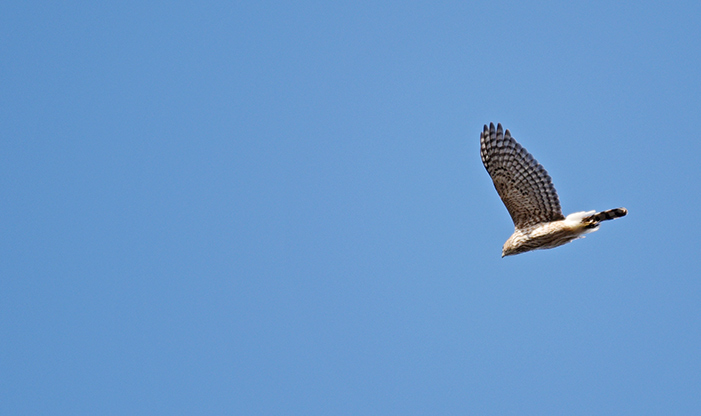Migration often inspires images of springtime and birds flying in to Wisconsin for our warm season. Those same animals also travel back to warmer climates for wintertime – so fall is also a fantastic time to witness migration. Hawk migration in particular takes place from mid-August through December and is one of the most awe-inspiring travels to witness.
Hawks in Our Skies
There are two classifications of hawks: Buteos and Accipiters. Buteos are the larger, broader-winged birds that drop down on their prey in a vertical manner. Red-tailed, Broad-winged, Red-shouldered, Rough-legged Hawks, as well as Northern Harriers, are Buteos found in Wisconsin. Accipiters have smaller wings and longer, more narrow tails than their Buteo brethren. These birds’ bodies have adapted to navigate a woodland environment and they can maneuver swiftly through trees in the pursuit of prey. Accipiters in this area include Northern Goshawks, Sharp-shinned Hawks, and Cooper’s Hawks.
While moving from breeding territories to wintering grounds, hawks are in search of food and, in some cases, more tolerable temperatures. Unlike songbirds that migrate under the protection of dark, these raptors utilize daytime thermals. Instead of expending effort flapping, their large wings soar upon rising warm air. Daytime flight creates a perfect opportunity to watch raptors soar through the sky.
Hawk Migration Along Lake Michigan
Migratory hawks follow Lake Michigan, taking advantage of thermals rising from bluffs and solid ground. In fact, they avoid crossing large bodies of water due to the lack of thermals, making our location on the lake a wonderful pathway for hawk migration. Broad-winged Hawks migrate thousands of miles from South America in spring. These hawks spend summers distributed widely throughout the eastern portion of North America, returning south in fall. Nicco the Broad-winged Hawk is an example of this species; Nicco is one of the feathered ambassadors in the Schlitz Audubon Raptor Program.
It’s important to note that not all hawks migrate. Red-tailed Hawks, for example, are considered partial migrants. Some individuals will stay because urban landscapes provide sufficient heat, shelter, and prey to make Wisconsin winters tolerable.
Seeing Hawk Migration at Schlitz Audubon
A cast of hawks with outstretched wings soaring above is a magical sight to behold, and Schlitz Audubon is a terrific location to witness their migration. You can increase your chances of seeing them after the passing of a cold front; northwesterly winds and calm weather promote strong hawk flights.
Our prairies provide wonderful opportunities to observe birds circling and scanning for a fly-thru meal of rodents, birds, or other small animals along their journey. Accipiters will pause for a tree branch perch while overlooking a prairie. The larger-winged Buteos will circle high above these grassy areas. The Nipissing Great Lakes Terrace along Lake Michigan is a wonderful, and often less visited, area to find raptors perched in trees or soaring above. Bald Eagles have been seen both perched on trees overlooking Lake Michigan and flying along the shore. Additionally, from our 60-foot observation tower, one has the opportunity to glimpse migrating birds, the beautiful Lake Michigan shore, and the fall colors as they develop.
Grab your binoculars, head outside and best of luck with your hawk migration adventures! If you’d like to learn how to identify raptors in the wild, join us for Raptor ID Workshop on Saturday, September 21 from 9:00am – 12:00pm.
Updated 9-2-24 to include 2024 program info.


